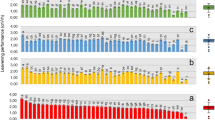Abstract
DURING work on vitamin E, we have been interested in obtaining animal diets rigorously freed of tocopherol. Methods of analysis now available1,2 allow amounts of tocopherol much less than 1 (µgm./gm. of diet to be determined and have already shown that many constituents of ‘Vitamin E-free’ diets in fact contain appreciable amounts of tocopherol. Of particular interest is yeast, which has usually been held to be devoid of tocopherol (for example, Forbes and György3). When several kinds of commercial dried bakers' yeast were analysed by the above methods they were found to contain small quantities of α-tocopherol (of the order of 0.3 µgm./gm.) Eventually, fresh compressed bakers' yeast (Distillers Co., Ltd., 3 kgm.) was lysed by a method4 using diethylamine as catalyst, and the solid residue was extracted with hot ethyl acetate. The extract was purified and analysed1 for α-tocopherol, ubiquinone-30 and ubichromenol-30. In Table 1 the results are compared with those found on a replicate batch of yeast autolysed with ethyl acetate and extracted with hot benzene–alcohol (a method5 used for ergo-sterol). It would appear that the former method is superior to the latter. The ubichromenol-30 was identified by comparing it with a synthetic specimen, prepared from ubiquinone-30 by Links's method6. Certain batches of yeast appeared to contain ubiquinone-35 instead of ubiquinone-30. The identity of the α-tocopherol was confirmed by isolating it chromatographically. The substance was strongly reducing, ran identically with α-tocopherol in two chromatographic systems, had an ultra-violet maximum at 291 mµ and an infra-red spectrum consistent with it being α-tocopherol.
This is a preview of subscription content, access via your institution
Access options
Subscribe to this journal
Receive 51 print issues and online access
$199.00 per year
only $3.90 per issue
Buy this article
- Purchase on Springer Link
- Instant access to full article PDF
Prices may be subject to local taxes which are calculated during checkout
Similar content being viewed by others
References
Diplock, A. T., Green, J., Edwin, E. E., and Bunyan, J., Biochem. J., 76, 563 (1960).
Edwin, E. E., Diplock, A. T., Bunyan, J., and Green, J., Biochem. J. (in the press).
Forbes, M., and György, P., J. Nutrit., 63, 461 (1967).
Brit. Patent 801,390 (1958).
Bills, C. E., Massengale, O. N., and Prickett, P. S., J. Biol. Chem., 87, 259 (1930).
Links, J., Biochim. Biophys. Acta, 38, 196 (1960).
Sugimura, T., and Rudney, H., Biochim. Biophys. Acta, 37, 560 (1960).
Cowlishaw, B., and Prange, I., Biochim. Biophys. Acta, 23, 663 (1957).
Lester, R. L., Crane, F. L., Welch, E. M., and Fechner, W. F., Biochim. Biophys. Acta, 32, 492 (1959).
Green, J., Price, S. A., and Gare, L., Nature, 184, 1339 (1959).
Author information
Authors and Affiliations
Rights and permissions
About this article
Cite this article
DIPLOCK, A., GREEN, J., EDWIN, E. et al. Tocopherol, Ubiquinones and Ubichromenols in Yeasts and Mushrooms. Nature 189, 749–750 (1961). https://doi.org/10.1038/189749a0
Issue Date:
DOI: https://doi.org/10.1038/189749a0
This article is cited by
-
Verbreitung und relative Konzentration der lipophilen Plastidenchionone in gr�nen Pflanzen
Planta (1968)
-
Enzymatic activity of basidiomycetes
Folia Microbiologica (1968)
-
Ubiquinone and Ubichromenol
Nature (1962)
-
Natural Occurrence of Ubichromenol
Nature (1962)
-
Ubiquinone (Coenzyme Q) and the Function of Vitamin E
Nature (1961)
Comments
By submitting a comment you agree to abide by our Terms and Community Guidelines. If you find something abusive or that does not comply with our terms or guidelines please flag it as inappropriate.


